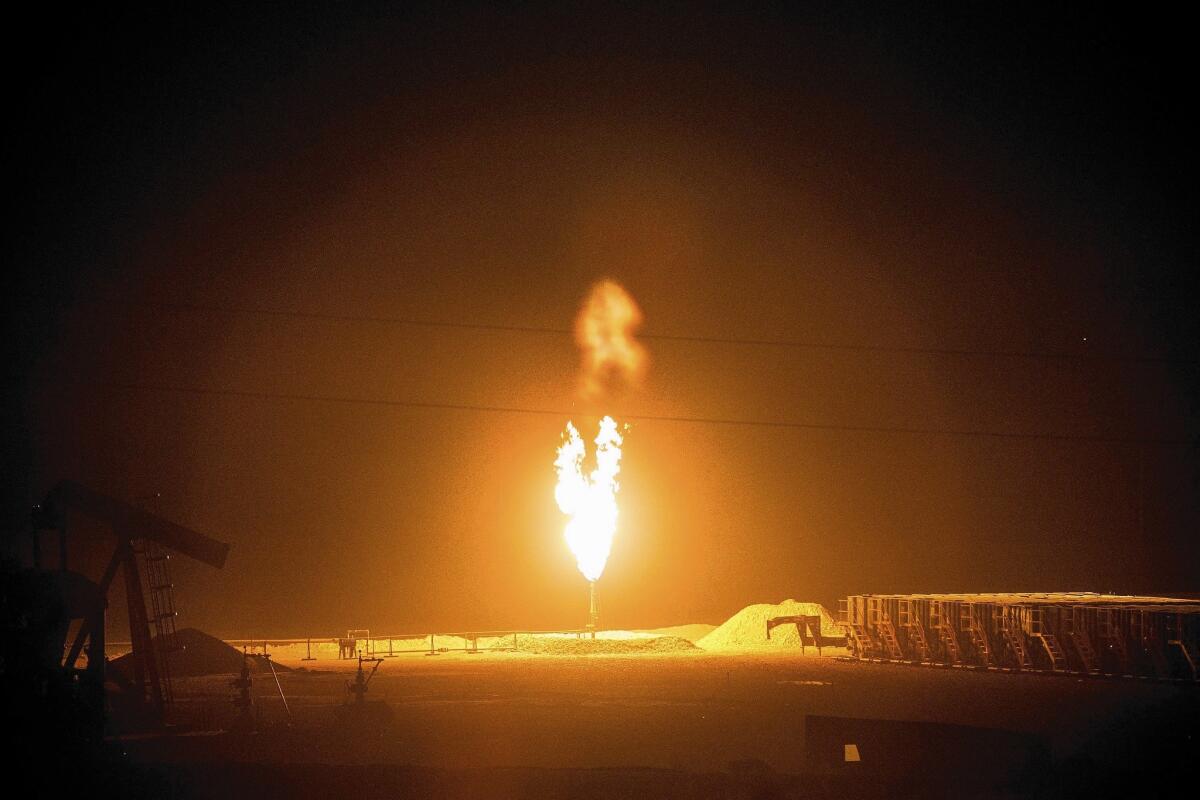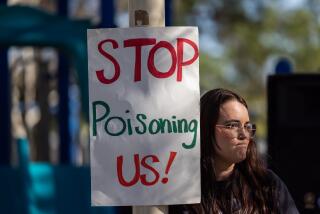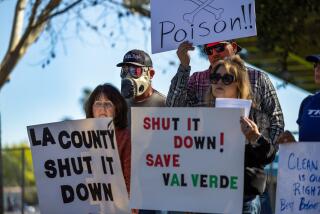Oil drilling in North Dakota raises concerns about radioactive waste

Every weekday, about a dozen large garbage trucks peel away from the oil boom that has spread through western North Dakota to bump along a gravel road to the McKenzie County landfill.
The trucks drive up to a scale flanked by something seldom found in rural dumps — two 8-foot-tall yellow panels that essentially form a giant Geiger counter.
Two or three times a day, the radiation detector blares like a squad car, because under tons of refuse someone has stashed yard-long filters clotted with radioactive dirt from drilling sites.
The “socks” are supposed to be shipped to out-of-state processing plants. But some oil field operators, hoping to save tens of thousands of dollars, dump the socks in fields, abandoned buildings and landfills.
FOR THE RECORD:
Oil field waste: In the July 27 Section A, an article about waste generated by oil drilling in North Dakota said that about a dozen garbage trucks visit the McKenzie County landfill each day. In fact, that many trucks arrive each hour. —
“It’s a game of cat-and-mouse now,” said Rick Schreiber, the landfill’s director. “They put the sock in a bag inside a bag inside a bag.”
Nearly 1,000 radioactive filters were found last year at the landfill, part of a growing tide of often toxic waste produced by the state’s oil and gas rush. Oil field waste includes drill cuttings — rock and earth that come up a well bore — along with drilling fluids and wastewater laced with chemicals used in fracking.
To many local and tribal officials, environmentalists and some industry managers in North Dakota, the dumping of the socks and the proliferation of other waste shows the government falling short in safeguarding the environment against oil field pollution.
The Environmental Protection Agency decided during the Reagan era to classify oil field waste as not hazardous, exempting it from tight controls and leaving it to be managed by widely varied state laws. Nationally, no one tracks how many millions of tons of waste the fossil fuel boom generates, or where it ends up.
The EPA exempts the waste, in part, because it considers state oversight adequate, despite what the agency calls “regulatory gaps in certain states.”
Most oil companies dump drilling waste into thousands of pits by their wells, but North Dakota, the second-largest oil-producing state behind Texas, does not test the pits’ contents or monitor nearby groundwater for contamination.
Rather than using instrumentation, North Dakota regulators visually inspect the on-site pits and “special waste” landfills to determine if the loads are wet or leaking.
“A lot of the stuff we deal with wouldn’t come here if it were designated as hazardous,” Schreiber said. “Hazardous waste has a manifest; it’s better tracked. Now, there’s no tracking, and it’s left to individual landfills like ours to deal with it.”
Indeed, Schreiber installed the radiation detectors on his own, not upon orders from the state.
The harshest reaction so far to North Dakota’s growing oil field waste has come from middle managers of several oil companies who formed a watchdog group, the Bakken Waste Watch Coalition, that has asked the regional office of the EPA to clamp down on the state.
“The waste is, in fact, toxic,” said one company manager, who like others in the group, requested anonymity for fear of losing his job. North Dakota “will see 12,000 more slop pits, some on top of known aquifers, in the next decade, seething with who-knows-what — then abandoned.”
Scott A. Radig, director of the state health department’s waste management division, countered that the EPA exemption is “working fine” in North Dakota.
“The huge majority of waste, if it had to be tested for hazardous characteristics, wouldn’t register as hazardous waste,” he said.
North Dakota has long produced oil, but the latest boom took off in 2006, when high-volume hydraulic fracturing, or fracking, tapped the northwestern Bakken shale formation.
Soon the deep green of durum wheat fields and shocking yellow of canola give way to rectangular lots of red scoria gravel studded with drilling rigs and horse head pumps. The area’s nearly 7,400 wells are the start of development that could bring another 40,000 wells in the next 20 years.
Last year, 1.75 million tons of oil field refuse went to special waste landfills, Radig said.
At least 80% of North Dakota’s oil companies dispose of millions more tons of drilling waste in pits near rigs, said Lynn Helms, director of the Department of Mineral Resources, which oversees oil development. North Dakota does not have an environmental protection agency.
Studies including by the EPA show that oil field waste contains substances dangerous to human health, especially if they enter groundwater. Benzene, for instance, is a carcinogen.
Radium and barium, naturally occurring radioactive elements, are sometimes brought up by drilling, an especially acute problem in North Dakota. The levels of radioactivity are low but the volumes great, and their potential effect is unclear.
“They are exempt from being classified as a hazardous waste but that doesn’t mean they are not hazardous,” said Bill Olson, a retired hydrologist who worked on New Mexico’s stricter 2008 oil field waste rules. (The administration of Gov. Susana Martinez, a Republican, weakened the rules last year.) Sampling in New Mexico and elsewhere has shown pits leaking into groundwater.
North Dakota requires cuttings be dry before the plastic-lined pits are buried, to reduce the risk of leaching. Oil field refuse at special waste landfills must be dry, too, under an agreement between the health department and the EPA.
The health department told the EPA it would conduct visual inspections and a more rigorous test that entails running oil field waste through a small paper filter to detect liquids. But in practice, North Dakota seldom, if ever, tests oil field waste for wetness.
“The reason it isn’t necessary is that it’s pretty easy to look at waste and tell if it’s wet or not,” Radig said. “It’s like being able to tell the difference between dirt and mud.”
Blaine Nordwall, attorney for the Bakken Waste Watch Coalition, argues that the state should rely on the more stringent filter test. “The problem with visual inspections is that they produce no data or records,” he said. “You could have thousands of gallons of liquid under loads of dirt.”
The mineral resources department relies exclusively on visual inspections, too.
“Is visual inspection enough? I think so,” Helms said. “If a pit has a problem with water, the diesel fuel comes to the surface.”
In January, the coalition asked the EPA to suspend its agreement with the health department until it begins testing special waste landfills for liquids. The agency has so far declined. An EPA official toured North Dakota special waste landfills, but conducted visual inspections in nearly every site.
The EPA says it cannot reclassify oil field waste as hazardous without legislative action, which, with the current Congress, is unlikely.
The coalition disputes the state’s assertions about the safety of on-site pits “because it’s our companies that are digging these pits, and we see what happens,” said the industry middle manager. “A pit is supposed to be above the water table, but we dig into it and weigh down the pit liner with rocks because there’s water all around it, until there’s more dirt dumped in.”
He rejected the idea that the coalition deliver samples of contaminated groundwater for regulators to act. “The burden is on the state to show us that the pits aren’t leaking,” he said. “It’s not for us to prove what’s happening at sites where you could get arrested for being at the wrong place.”
North Dakota regulators say they have no plans for new oil field waste regulations, though the health department plans to issue rules to track disposal of radioactive socks, spurred in part by the discovery in February of tons of filters dumped two miles south of the McKenzie County landfill.
More to Read
Start your day right
Sign up for Essential California for news, features and recommendations from the L.A. Times and beyond in your inbox six days a week.
You may occasionally receive promotional content from the Los Angeles Times.







